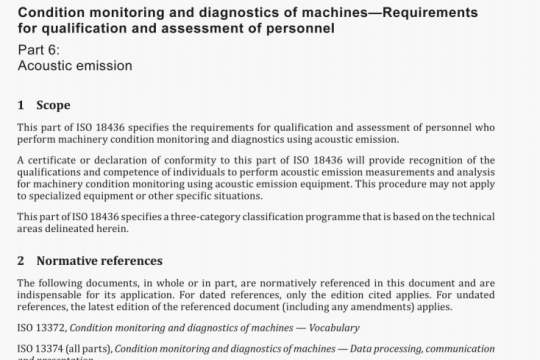BS ISO 4689-3:2017 pdf free
BS ISO 4689-3:2017 pdf free.Iron ores一Determination of sulfur content
Connect the furnace (6.4) with components (6.1, 6.2, 6.3, 6.5, 6.8, 6.9, and 6.10) and switch on the power.Set the condition for heating in accordance with the manufacturer’s instructions after stabilization of the apparatus.
Analyse a standardization sample as follows.
a) Adjust the reading of the detector to the sulfur content of the standardization sample. Place the test portion in a refractory combustion crucible (6.6) and cover the test portion with 0,50 g of iron (5.1), 0,3 g to 0,5 g of tin (5.4), and 1,0 g of tungsten (5.5) in that order. For 0,2 g of sample, cover the test portion with 0,8 g of iron, 0,3 g to 0,5 g of tin, and 1,0 g of tungsten in that order.
b) Insert the crucible into a quartz combustion tube (6.5) of the furnace at the centre position of the heating induction coil. Substitute oxygen for air in the combustion tube, adjust the inner pressure to the specified pressure and load the power to the heating induction coil. Continue combustion of the test portion until the reading of the detector does not vary. Read out and record the indicated value. Switch off the power and take out the crucible.
c) After combustion, the used crucible shall be checked to determine whether the combustion is complete or not.
d) If incomplete, the test shall be carried out again.
A standardization sample means a sample used for adjusting the sensitivity of a detector. It should not easily degenerate and should be homogeneous.
NOTE An apparatus equipped with a timer stops automatically.
Decant water and sulfur standard solution (5.8), in accordance with Table 2, into five tin capsules (6.7).Heat each capsule gently at 90 °C, to dryness, and cool in a desiccator.
Place the dried capsule in a refractory combustion crucible (6.6) and press the capsule against the bottom of the crucible. Cover the capsule with 0,5 g of iron oxide (5.3), 0,5 g of iron (5.1), and 1,0 g of tungsten (5.5) in that order.
Treat each crucible as described in 8.4. Plot the relationship between the quantity of sulfur, in micrograms, and the net reading.
Several CRMs may be used instead of sulfur standard solutions. In this case, the sulfur contents of the CRMs should cover the applicable range of this method. CRMs should be treated as indicated in 8.3 and 8.4.BS ISO 4689-3 pdf download.




